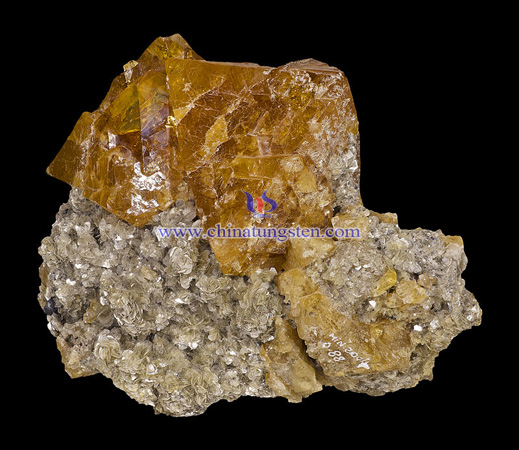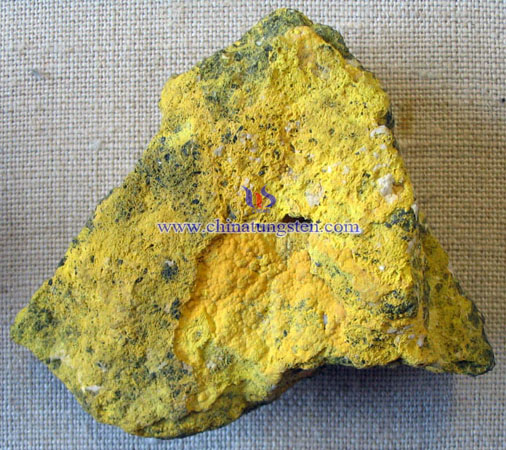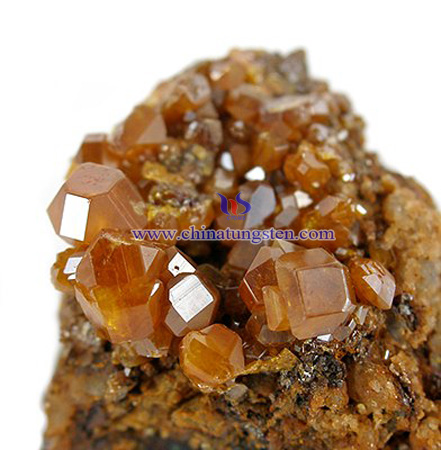Tungsten Minerals: Scheelite, Tungstite, Stolzite
- Details
- Category: Tungsten Information
- Published on Tuesday, 05 January 2016 17:36
In the mineralization, most majority of tungsten forms into oxides (tungstate) , rarely sulfide, no natural tungsten. Currently it’s found only about 20 kinds of tungsten ores and minerals containing tungsten in the crust.
Scheelite:
Scheelite is a calcium tungstate mineral with the chemical formula CaWO4. It is an important ore of tungsten. Well-formed crystals are sought by collectors and are occasionally fashioned into gemstones when suitably free of flaws. Scheelite has been synthesized via the Czochralski process; the material produced may be used to imitate diamond, as a scintillator, or as a solid-state lasing medium. It was also used in radium paint in the same fashion as was zinc sulphide, and Thomas Edison invented a fluoroscope with a calcium tungstate-coated screen, making the images six times brighter that those with barium platinocyanide; the latter chemical allowed Röntgen to discover X-rays in early November 1895.


Tungstite:
Tungstite is a hydrous tungsten oxide mineral with formula: WO3·H2O. It is a secondary mineral formed by the weathering of other tungsten containing minerals. It crystallizes in the orthorhombic system in translucent yellow to yellow green masses. It is clay-like with Mohs hardness of 2.5 and a specific gravity of 5.5.
It was first described in 1868 for an occurrence near Trumbull, Connecticut at the Hubbard Tungsten Mine at Long Hill.

Stolzite:
Stolzite is a mineral, a lead tungstate; with the formula PbWO4. It is similar to, and often associated with, wulfenite which is the same chemical formula except that the tungsten is replaced by molybdenum. Stolzite crystallizes in the tetragonal crystal system and is dimorphous with the monoclinic form raspite.
Lead tungstate crystals have the optical transparency of glass combined with much higher density (8.28 g/cm3 vs ~2.2 g/cm3 for fused silica). They are used as scintillators in particle physics because of the their short radiation length (0.89 cm), low Molière radius (2.2 cm), quick scintillation response, and radiation hardness. Lead tungstate crystals are used in the Compact Muon Solenoid's electromagnetic calorimeter.
It was first described in 1820 by August Breithaupt, who called it Scheelbleispath and then by François Sulpice Beudant in 1832, who called it scheelitine. In 1845, Wilhelm Karl Ritter von Haidinger coined the name stolzite for an occurrence in Krusne Hory (Erzgebirge), Czech Republic, naming it after Joseph Alexi Stolz of Teplice in Bohemia. It occurs in oxidized hydrothermal tungsten-lead ore deposits typically in association with raspite, cerussite, anglesite, pyromorphite and mimetite.


| Tungsten Supplier: Chinatungsten Online www.chinatungsten.com | Tel.: 86 592 5129696; Fax: 86 592 5129797;Email:sales@chinatungsten.com |
| Tungsten News & Prices, 3G Version: http://3g.chinatungsten.com | Molybdenum News & Molybdenum Price: http://news.molybdenum.com.cn |



 sales@chinatungsten.com
sales@chinatungsten.com